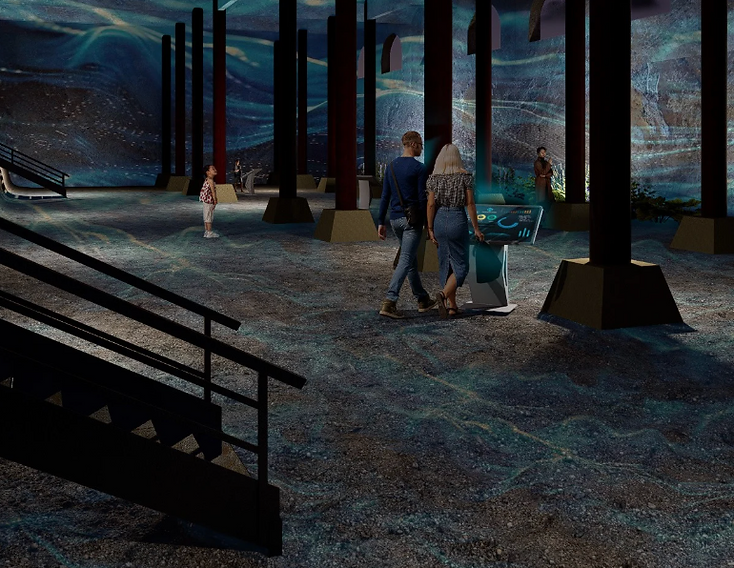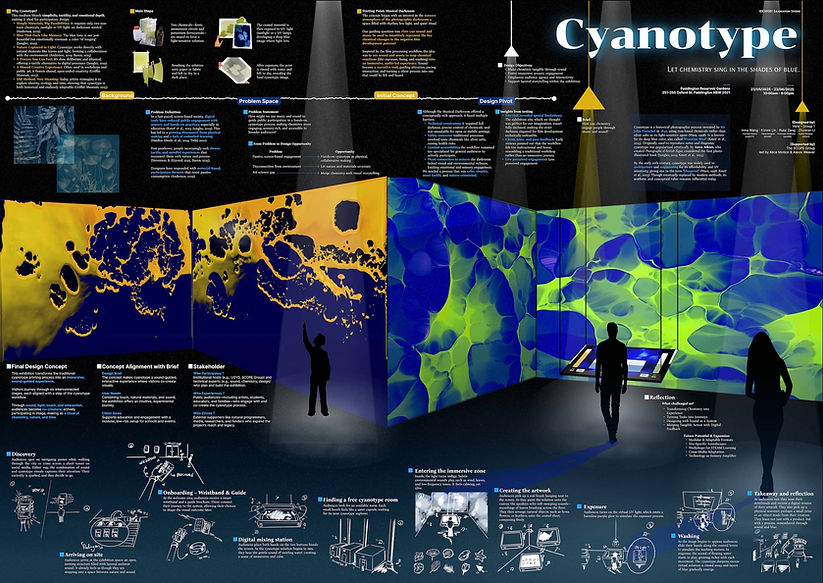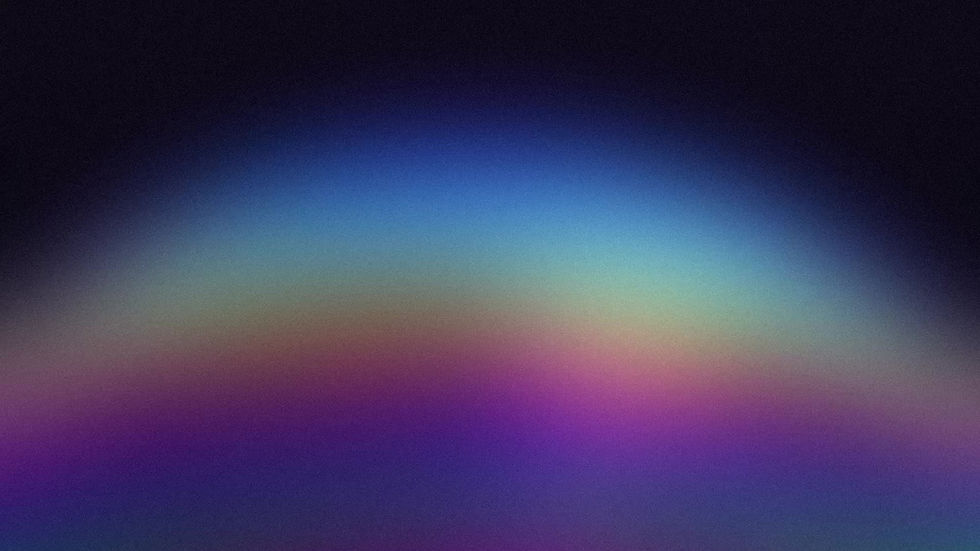


Cyanotype
background
Film offers a unique ritualistic and archival value, yet few people practice cyanotype printing firsthand. While some enthusiasts attempt it at home, most are deterred by high costs, equipment scarcity, and the complexity of the process.In today's fast-paced society, people often lack the time to learn and practice cyanotype. The need for special tools, hard-to-find materials, and multiple steps creates a high barrier for beginners.
As digital photography becomes the norm due to its convenience, analog methods like cyanotype have become niche and nostalgic. The decline in industry support has made tools and chemicals less accessible, pushing traditional photographic techniques further into obscurity. At the same time, the rise of instant sharing culture favors quick results, leaving little room for slow, hands-on processes like cyanotype.
Today, traditional techniques are often seen as skills reserved for experts. This "expert-only" perception limits broader participation, especially among casual creatives who may be interested but feel intimidated.Chemistry education faces a similar challenge: abstract and complex, it often feels distant from real life. As a result, fewer people engage with hands-on chemical processes like cyanotype, missing opportunities to explore science through creative action.
Cyanotype is both an artistic and scientific process, where visual images emerge from light and chemical reactions. This project aims to make it more approachable by combining chemistry with sensory experience. Through creative tools and immersive interaction, we hope to revive cyanotype in the digital age and reconnect people with the beauty of physical making and scientific curiosity.

Why Cyanotype?
Simple Materials, Big Possibilities
It requires only two non-toxic chemicals, sunlight or UV light: no darkroom needed (Anderson, 2019).
Blue That Feels Like Memory
The blue tone is not just beautiful but emotionally resonant: a color “of longing” (Jungles, 2019).
Nature Captured in Light
Cyanotype works directly with natural elements like leaves and light, forming a collaboration with the environment (Anderson, 2019; Baron, 2025).
A Process You Can Feel
It’s slow, deliberate, and physical, offering a tactile alternative to digital processes (Jungles, 2019).
A Shared Creative Experience
Often used in workshops and public art, it fosters shared, open-ended creativity (Griffin Museum, 2023).
"What does a cyanotype chemical reaction sound like?"


As light meets iron salts, images slowly emerge. We want to give rhythm and emotion to this process through sound — letting people hear the breath of chemistry.
Core Elements of Cyanotype
🧪 Two chemicals—ferric ammonium citrate and potassium ferricyanide—are mixed to form a light-sensitive solution.

🌞 The sun becomes the artist — UV rays activate the chemical transformation that brings the image to life.

🔵 Iron quiet force behind the process. Iron salts are sensitive yet stable, grounding the chemistry in deep blue.


🌊 Water washes away the unexposed areas, revealing the hidden image. It purifies, dissolves, and completes.

We miss the moments when life slows down.
Cyanotype is a warm and tactile chemical process — a love letter sent to the sun.When science becomes something you can hear, touch, and feel, learning is no longer just about memorizing formulas.
Starting Point
Musical Darkroom
The concept began with an interest in the sensory atmosphere of the photographic darkroom: a space filled with rhythm, low light, and quiet ritual.
Our guiding question was: How can sound and music be used to intuitively represent the key chemical changes in the negative film development process?
Inspired by the film processing workflow, the idea was to use sound and music to map chemical reactions (like exposure, fixing, and washing) into an immersive, audio-led experience. Sound became a narrative tool, guiding attention, pacing interaction, and turning a silent process into one that could be felt and heard.



In a fast-paced, screen-based society, digital tools have reduced public engagement with sensory and hands-on practices, especially in education (Kmet’ et al., 2023; Jungles, 2019). This has led to a growing disconnect from physical making and a lack of embodied learning (Vanden Abeele et al., 2024; Todd, 2021).
Post-pandemic, people increasingly seek slower, tactile, and mindful experiences that reconnect them with nature and process (Stevenson & Alzyood, 2025; Baron, 2025).
Designers have responded with material-based, participatory formats that resist passive consumption (Anderson, 2019).
SO
How might we use music and sound to guide public participation in a hands-on cyanotype process, making chemistry more engaging, sensory-rich, and accessible to broader audiences?
From Problem to Design Opportunity
Problem
Opportunity
Passive, screen-based engagement
Hands-on cyanotype as physical, collaborative making
Disconnection from environment
Let nature and materials co-create
Art-science gap
Merge chemistry with visual storytelling
Problem Space

Design Pivot
Although the Musical Darkroom offered a conceptually rich approach, it faced multiple barriers:
Technical constraints:
it required full darkness, precise control of chemicals, and was unsuitable for open or mobile settings.
Safety concerns:
traditional processes involved toxic chemicals like silver salts, raising health risks.
Limited accessibility:
the workflow remained too specialized for general audiences to actively participate.
Weak connection to nature:
the darkroom lacked visual and environmental richness, limiting emotional and sensory engagement.
We needed a process that was safer, simpler, more tactile, and nature-connected.
Insights from testing
Site visit revealed spatial limitations: The exhibition site, which we thought was perfect for our imagination, wasn’t fully enclosed, making the strict darkness required for film development technically unfeasible.
Client, tutor, and peer feedback:
Early reviews pointed out that the workflow felt too instructional and linear, resembling a traditional workshop rather than an immersive journey.
Low perceived engagement:
Low perceived engagement

methodologies
To create an innovative, engaging, and educational exhibition that effectively conveys chemistry through music, we propose a hybrid research methodology that extends the traditional Double Diamond framework by integrating Triple Loop Learning (Aston, 2021) and Speculative Design on a Human-centered basis. This approach ensures a structured yet flexible process that prioritizes creativity, interdisciplinary collaboration, and user engagement.
Our primary goal is to promote science communication through this methodology and exhibition and enable audiences to perceive chemistry in a new way. Unlike traditional passive learning methods, we aim for the exhibition to reshape visitors' understanding of chemistry. Rather than being mere spectators, visitors will actively participate in the design process—where their interactions, choices, and explorations directly influence the final output. This hybrid methodology allows us to connect diverse fields rather than addressing a single problem in isolation, making it well-suited for an innovative, research-driven, interdisciplinary exhibition that enhances the forward-thinking and experimental nature of the project.
.png)


ETHNOGRAPHY
We conducted ethnographic research targeting film photography enthusiasts, focusing on their perceptions of cyanotype, motivations for using it, hands-on experiences, understanding of the chemistry behind the process, and impressions of the auditory environment during cyanotype printing (see Appendix for details). Through online ethnography and offline interviews, we identified key insights and categorized them into four themes: Emotional Motivation, Experience Perception, Sound in the Process, and Chemistry Knowledge. Through analytical insights, we established personas.
From Interview

.png)
Tom Brady
Age: 32 Location: Sydney
Experimental Visual Artist
“I don’t just make art, I discover it through the process.”
Goals:
-
Explore new forms of visual expression through tactile and unpredictable processes
-
Engage with exhibitions that encourage co-creation, not just observation
-
Discover mediums that blend art, science, and nature
Pain Points:
-
Disconnected from digital, screen-based tools
-
Finds traditional photography (e.g. darkrooms) rigid and closed-off
-
Wants a more intuitive, playful way of creating
Needs:
-
A space for improvisation and process-led discovery
-
Tools that welcome mistakes as part of the creative outcome
-
A method that’s sensory, analog, and open to chance


Final Design Concept
This exhibition transforms the traditional cyanotype printing process into an immersive, sound-guided experience. Visitors journey through six interconnected stages, each aligned with a step of the cyanotype workflow Through sound, light, touch, and interaction, audiences become co-creators: actively participating in image, making as a ritual of chemistry, nature, and time.
A series of interactive sound and visual installations that transform each stage of the cyanotype process into a distinct auditory experience.
A hands-on cyanotype experience where visitors actively mix, expose, and develop their own cyanotype prints.
An immersive spatial journey.

What are we designing?
We are designing an immersive, sound-driven exhibition that reimagines the cyanotype chemical process through interaction, water-based nature soundscapes, and spatial storytelling.
Each phasesuch is represented by a base layer of flowing water sounds, with carefully layered additions (e.g., the sound of brushing leaves during coating) to reflect the actions and natural associations of that step. These subtle variations allow visitors to feel the transformation and nature-inspired rhythm of the process.
While the base sounds remain consistent for each stage, the layering and intensity subtly adjust based on individual interaction, creating a personalized sonic imprint.
The route is designed to mirror the cyanotype’s transformation: beginning in dark, enclosed spaces (evoking unexposed material), transitioning through brighter areas representing UV exposure, and concluding in an open, sunlit zone that suggests washing and image development.

Bringing Ideas to Life
Final Prototype & User Flow
Project Type
Temporary installation (1 month)
Dates
May 23 – June 23, 2025 Conclude the Vivid Sydney period (23 May–14 June 2025)

📍Paddington Reservoir Gardens 251-255 Oxford St, Paddington NSW 2021
This capstone project was awarded the top rank in the program, received a High Distinction (HD) grade, and earned a recommendation letter from the supervising professor.


1. Discovery
Audiences spot an intriguing poster while walking through the city or come across a short teaser on social media. Either way, the combination of sound and cyanotype visuals captures their attention. Their curiosity is sparked, and they decide to go.

Poster
Poster
Graphic Design
Brochure Graphic Design

Side A
.jpeg)
Side B


2.
Arrival & Entry
Zone A
Audiences arrive at the exhibition space: an open, inviting structure filled with layered ambient sound. It already feels as though they are stepping into a space between nature and sound.




3.
Onboarding – Wristband & Guide
Audiences arrive at the exhibition space: an open, inviting structure filled with layered ambient sound. It already feels as though they are stepping into a space between nature and sound.

4.
Digital mixing station
Audiences place both hands on the two buttons beside the screen. As the cyanotype solution begins to mix, they hear the gentle sound of swirling water, creating a sense of immersion and calm.


Zone B

Music × Humans × Screens = A New Chemical Reaction


5.
Finding a free cyanotype room
Zone C
Audiences look for an available room in ZONE C. Each small booth feels like a quiet capsule, waiting for its next cyanotype explorer.


6.
Entering the immersive zone
Inside, the light turns indigo. Subtle environmental sounds play, such as wind, leaves, and low-frequency tones. It feels calming, yet alive.
Creating the artwork
Audiences pick up a real brush hanging next to the screen. As they paint the solution onto the canvas, the speakers echo soft sweeping sounds—recordings of leaves brushing across the floor. They then arrange natural objects, such as ferns, flowers, or feathers, onto the coated sheet, composing freely.


Audiences turns on the virtual UV light, which emits a harmless purple glow to simulate the exposure process.



7.
Washing
Zone D
As the image begins to appear, audiences slide their hands along the control levers to simulate the washing motion. In response, the sound of flowing water starts to play, growing richer with each movement. The cyanotype deepens, excess virtual solution is rinsed away, and layers of blue gradually emerge.


After completing their cyanotype work, visitors can use gestures to zoom in on the image and trigger sound feedback, further extending their sensory connection and immersive experience with their own creation.


8.
Takeaway and reflection
As audiences exit, they scan their wristbands and receive a digital version of their artwork. They also pick up a physical souvenir, perhaps a small print or an object made from their creation. They leave not just with a product, but with a process, remembered through sound and blue.

1.Highlights from the Exhibition
A documentation of the exhibition’s immersive experience through photos, videos, sound samples, and behind-the-scenes stories.
2.Science and musical knowledge
After the exhibition:
Sustainably available
To ensure that the impact of our exhibition extends beyond the physical event, we will launch a dedicated project website. This platform acts as a digital extension of the exhibition, making the cyanotype experience accessible, educational, and sustainable for a wider audience.
Use storyboards to explain the process and chemical reactions of cyanotype production, allowing the audience to continue learning and gain full understanding
3.Artist Gallery
A curated selection of cyanotype artworks created by participating artists and users, showcasing creative interpretations and techniques.
4.Cyanotype DIY Kit Store
Visitors can purchase beginner-friendly cyanotype kits, including pre-mixed solutions, instruction cards, and paper—allowing them to continue creating at home.
5.Website: Community & Sharing Space
The website offers a place to revisit the exhibition, access creative tools, and share your work — keeping the experience alive and the community connected.
Prototype
1.
On-site Mini Exhibition
Organized a small-scale physical exhibition on campus, where over 20 faculty members and students participated in interactive user testing and provided valuable feedback for design iteration.






I worked with my lovely teammates — four of us from diverse academic backgrounds — to collaboratively develop the concept and bring the project to life. Each member contributed their unique strengths, taking on different roles to support the collective vision. Through close teamwork and mutual respect, we successfully delivered this large-scale project.
3.
Design Research Report
4.
Poster


Reflection
What changed our minds and the design?
Future Potential & Expansion
As we developed the concept, we realized this wasn’t just about adding sound to a process, it was about letting sound become the logic of the experience. Rather than treat cyanotype as a fixed sequence, we began to design it like a performance: one shaped by rhythm, gesture, and response.
This shift pushed us to rethink how each step could be felt through sound, not just explained. For example, brushing the cyanotype solution is paired with the sound of leaves sweeping stone, exposure becomes a low-pitched drone, and rinsing is accompanied by flowing water tones. These sounds not only mirror the process, they guide the body, set the pace, and invite interpretation.
We also moved away from trying to simulate a photographic lab and instead embraced a hybrid space: where traditional image-making meets interactive media and sonic storytelling. This allowed us to keep the cyanotype process grounded in materiality, while also layering in digital elements that amplify attention and emotional presence, making the connection between nature and technology tangible.
Rather than replacing physical making, tech here amplifies attention, helping users rediscover materiality in fresh, intuitive ways.
Future versions can use local sounds, seasonal patterns, or real-time data for deeper environmental connection.
The experience model can expand into chemistry + art programs, supporting creative learning.
Modular and adaptable format
Site-specific soundscapes
Technology as sensory amplifier
Workshops for STEAM Learning
Cross-Media Adaptation
Easily installed in schools, galleries, or festivals thanks to safe materials and flexible design.
The interactive sound system could apply to other analog art forms, like printmaking, ceramics, or botanical photography.

References:
Anderson, C. (2019). Cyanotype (1st edition). Focal Press.
Baron, E. (2025, March 12). Artist creates monumental cyanotypes exploring the differences between analog and digital art [Interview]. My Modern Met.
https://mymodernmet.com/wu-chi-tsung-fading-origins-sean-kelly-gallery-los-angeles/
Culp, S., & Culp, S. (2024, July 27). Welcome to Hong Kong’s Pitch Black ‘Empty Gallery’ VICE. https://www.vice.com/en/article/empty-gallery-is-a-singular-new-space-for-media-art-in-hong-kong/
Fiorito, P. A., & Polo, A. S. (2015). A New Approach toward Cyanotype Photography Using Tris-(oxalato)ferrate(III): An Integrated Experiment. Journal of Chemical
Education, 92(10), 1721–1724. https://doi.org/10.1021/ed500809n
Griffin Museum of Photography. (2023). Expanded Cyanotypes. https://griffinmuseum.org/show/expanded-cyanotypes/
Jungles, A. (2019). Beyond the Blue: Cyanotype's Qualities of Light, Time, and Space.
Kmet’, A., Drozdíková, A., Nagyová, S., & Ikhardt, P. (2023). The Cyanotype Process and Its Potential in Chemistry Education. Journal of Chemical Education, 100(6),
2367–2372. https://doi.org/10.1021/acs.jchemed.2c01089
Miranda, E. R. (2023). Making music with enzymes. Transcript Verlag EBooks, 92–105. https://doi.org/10.1515/9783839465165-009
Paddington Reservoir Gardens. (n.d.). Tzg.com.au; TZG. https://tzg.com.au/project/paddington-reservoir-gardens/
Stevenson, H., & Alzyood, M. (2025). Healing through art: a thematic synthesis within a quasi-systematic review of art’s impact on adult mental well-being during the
COVID-19 pandemic. BMC Public Health, 25(1). https://doi.org/10.1186/s12889-025-22741-0
Sydney Festival. (n.d.). Paddington Reservoir Gardens - Sydney Festival. https://2021.sydneyfestival.org.au/venues/paddington-reservoir
Thomas.wilhelm@dnsw.com.au. (2025, May 23). Vivid Sydney | Light, Music & Ideas Festival. Vivid Sydney. https://www.vividsydney.com/
Todd, S., Hoveid, M. H., & Langmann, E. (2021). Educating the Senses: Explorations in Aesthetics, Embodiment and Sensory Pedagogy. Studies in Philosophy and
Education, 40(3), 243–248. https://doi.org/10.1007/s11217-021-09776-7
Urankar, N. (2024, March 1). How to make Cyanotypes on Paper? | Step by Step Tutorial + VIDEO. Zebra Dry Plates. https://zebradryplates.com/making-cyanotype-
step-by-step-tutorial/
Vanden Abeele, M. M. P., Vandebosch, H., Koster, E. H. W., De Leyn, T., Van Gaeveren, K., de Segovia Vicente, D., Van Bruyssel, S., van Timmeren, T., De Marez, L.,
Poels, K., DeSmet, A., De Wever, B., Verbruggen, M., & Baillien, E. (2024). Why, how, when, and for whom does digital disconnection work? A process-based
framework of digital disconnection. Communication Theory, 34(1), 3–17. https://doi.org/10.1093/ct/qtad016
Ware, M. (1998). Herschel’s Cyanotype: Invention or discovery? History of Photography, 22(4), 371–379. https://doi.org/10.1080/03087298.1998.10443901




